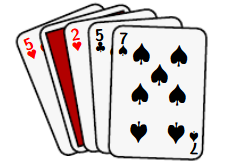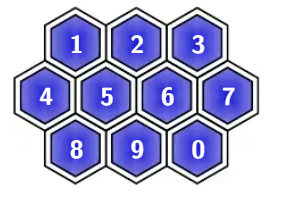Australian Mathematics Competition - 2023 - Junior years - Grade 7 & 8 - Questions and Solutions
 Join Trial or Access Free Resources
Join Trial or Access Free Resources Join Trial or Access Free Resources
Join Trial or Access Free ResourcesKurt paved his courtyard in the pattern shown. How many \(1 \times 1\) pavers are in his courtyard?

(A) 28
(B) 30
(C) 32
(D) 34
(E) 36
Which of the following expressions has the smallest value?
(A) (3+2)
(B) (3-2)
(C) \(3 \times 2\)
(D) \(3 \div 2\)
(E) 32
The numbers on the top corners of these five playing cards add to 21. What is the number on the hidden card?

(A) 2
(B) 3
(C) 5
(D) 7
(E) 9
What is the value of (x) in this diagram?

(A) 50
(B) 60
(C) 70
(D) 80
(E) 100
These two clocks show the opening and closing times of my local Marine Discovery Centre. For how long is it open each day?

(A) 5 hours and 40 minutes
(B) 6 hours and 20 minutes
(C) 6 hours and 40 minutes
(D) 7 hours and 20 minutes
(E) 7 hours and 40 minutes
What is the value of \(\frac{2+3+4}{7+8+9}\)?
(A) \(\frac{1}{6}\)
(B) \(\frac{2}{7}\)
(C) \(\frac{3}{8}\)
(D) \(\frac{4}{9}\)
(E) \(\frac{1}{2}\)
How many \(25 \mathrm{~cm} \times 25 \mathrm{~cm}\) squares fit in a \(50 \mathrm{~cm} \times 1 \mathrm{~m}\) rectangle?

(A) 1
(B) 2
(C) 4
(D) 6
(E) 8
This graph shows the water stored in my rainwater tank last May. What was the increase in water in the tank between the 10th and the 30th of May?

(A) 32 kL
(B) 37 kL
(C) 40 kL
(D) 42 kL
(E) 43 kL
The sum of the ages of Ali, Bey and Cam is 32 years. What will be the sum of their ages in 3 years?
(A) 33 years
(B) 35 years
(C) 38 years
(D) 41 years
(E) 96 years
A parallelogram \(P Q R S\) has an area of \(60 \mathrm{~cm}^2\) and a side \(P Q\) of length 10 cm. Which length is 6 cm?

(A) \(R Q\)
(B) \(R S\)
(C) \(Q T\)
(D) \(P T\)
(E) \(Q S\)
Mei can travel to her grandma's house by a direct route, or by a scenic route that is 5 km longer. When she travels by the scenic route and comes directly home, the round trip is 35 km. How long is the direct route?
(A) 5 km
(B) 12.5 km
(C) 15 km
(D) 20 km
(E) 22.5 km
In the game of Nurdle, players try to guess a three-digit number. After each guess, the digits are marked with one of the following three symbols:
\(\checkmark\) if the digit is correct and in the right place
\(\odot\) if the digit is correct but is not yet in the right place
\(\times\) if the digit is not in the three-digit number at all.

Mike's guesses so far are shown. How many different three-digit numbers fit the clues he has so far?
(A) 5
(B) 6
(C) 7
(D) 8
(E) 9
In this triangle, the number in the centre of each side is the sum of the two numbers at the ends of the sides. What is the sum of the three numbers at the ends of the sides?

(A) 46
(B) 52
(C) 59
(D) 64
(E) 68
A fuel tank is \(40 \%\) empty. Then 40 litres of fuel is removed. The tank is now \(40 \%\) full. How many litres are in a full tank?
(A) 40
(B) 100
(C) 160
(D) 200
(E) 400
The game Tutu uses 4 standard dice with opposite faces adding to 7 . The dice are rolled and randomly arranged into a \(2 \times 2\) block.

A block's score is the sum of the 4 numbers showing on top plus the sum of the 8 numbers showing around the outside.
What is the largest possible score for the block shown?
(A) 44
(B) 46
(C) 48
(D) 50
(E) 52
The five clocks below are all showing the wrong time. One clock is 3 minutes away from the correct time and another is 7 minutes away. Which clock is closest to the correct time?

I wrote a list of all multiples of 7 between 1 and 500. Then I looked at the last digit of each number in my list.
Which digit appeared most often as the last digit?
(A) 1
(B) 3
(C) 7
(D) 9
(E) None of (A)-(D), because there is no single last digit that appears most often
Amy designed this rectangular flag for her fleet of yachts. What fraction of the flag is shaded?

(A) \(\frac{2}{3}\)
(B) \(\frac{3}{5}\)
(C) \(\frac{5}{8}\)
(D) \(\frac{1}{2}\)
(E) \(\frac{7}{12}\)
Daniyal enters a code on the keypad to unlock a security door. To make it easy to remember:

What is the 5th digit of Daniyal's code?
Jake had 3 times as many gold balloons as blue balloons, and no other colours. Then some blew away, leaving him with 5 times as many blue balloons as gold balloons.
What is the smallest number of balloons that Jake could have started with?
(A) 15
(B) 20
(C) 24
(D) 30
(E) 100
Li attempted to multiply a single-digit number by 36 , but he accidentally multiplied by 63 instead. His answer was 189 larger than the correct answer. What was the correct answer to the multiplication?
(A) 180
(B) 189
(C) 216
(D) 252
(E) 288
The numbers from 1 to 12 are to be placed on the vertices of the 5 interconnected squares in this diagram. The sum of the 4 vertices of any of the 5 squares is a constant. What is this constant?

(A) 26
(B) 28
(C) 30
(D) 32
(E) 34
Ann is running around her favourite running course at a steady pace of 5 minutes per kilometre. She passes a marker which she knows is one-quarter of the way round. One minute and 40 seconds later, she passes another marker which is one-third of the way round. How long will it take her to run the whole course?
(A) 18 minutes
(B) 20 minutes
(C) 20 minutes and 40 seconds
(D) 22 minutes and 30 seconds
(E) 24 minutes
Jaz unlocked a secret level in the game Numbercraft. She entered a 6-digit code where the sum of the first three digits equals the sum of the last three digits. Further, she gained a bonus, since her code had four 7 s in a row.
For instance, she could have entered 077770.

How many different codes could she have entered to get the secret level and the bonus?
(A) 10
(B) 18
(C) 20
(D) 27
(E) 64
Two identical dice have faces labelled \(\mathrm{A}, \mathrm{C}, \mathrm{H}\), \(\mathrm{M}, \mathrm{S}\) and \(T\) .

The diagram shows what they look like when placed in front of a mirror, but the reflection of the second dice has been left blank.
What does the reflection of the second dice look like?

I start with a number, multiply it by 10, and then subtract a multiple of 9 that is less than 100. My answer is 5347. What number did I start with?
Amelia noticed that the names of three friends, Mei, Emma and Liam, were all made from letters of 'Amelia'. She chose different values from 0 to 9 for each of (A, E, I, L) and (M) so that
\(M+E+I=E+M+M+A=L+I+A+M\)
What is the largest possible value of (A+M+E+L+I+A) ?
There are three sets of three parallel lines in a plane. Lines in different sets are not parallel, and every pair of non-parallel lines intersect. The diagram shows one way to do this, but for other arrangements, the number of points of intersection varies.

Find the largest possible number of intersection points and the smallest possible number of intersection points, then multiply these two numbers.
A two-digit number has the property that when it is divided by the sum of its digits the result is 4 with remainder 3. What is the sum of all two-digit numbers with this property?
Click here to get the detailed solution.
Donna likes all numbers that are not divisible by 3 and Sandra likes all numbers that have no digits divisible by 3 . How many four-digit numbers are there that both Donna and Sandra like?
E